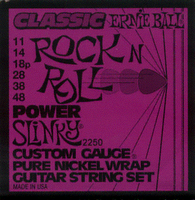"Guitar Strings and Foolish Things"

A couple weeks back I tuned up my Tele. Cleaned up the fretboard with lem-oil and steel wool and replaced the strings. Here be the lesson: always find out what strings are on a guitar when you buy it. If you like 'em you can replace them identically and if not you know where not to begin the search.
I loved the tone I got from the old strings and the new D'Addario 10-46s did not match up. When they weren't buzzing they sounded tinny and nasal, but I thought I just needed a heavier gauge, and I was sure I had 10s originally, so I went to the fat bottom 10-52. How can they be thick and thin at the same time? Plinky leads and razzy low-end. At least they didn't buzz, but it felt like climbing a wall going from the thin G to the thick D, and they still sounded like crap.
So I email Capsule and Peter (the co-owner that spec'ed and assembled my Tele from choice parts to resemble a '62 Custom) got back to me in under five minutes, knowing exactly the guitar I asked about and informed me of the strings of choice: Ernie Ball Classic Pure Nickel .011s
From the Ernie, "In the early sixties I developed the first Custom Gauge guitar string sets for rock & roll. They were wound with pure nickel, producing a warm, rich sound. As rock entered the 1970's players wanted more brightness so Slinkys switched to a nickel plated steel winding. The 80's demanded even more cutting power, and we came out with a separate line of Slinky strings having a wrap of stainless steel. Now, many guitarists want to recapture that original pure nickel sound, so here is the Classic series original Slinky set"

0 Comments:
Post a Comment
<< Home